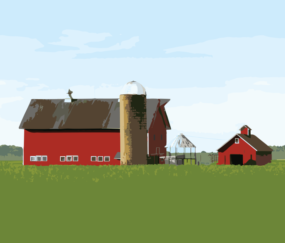In a state where they are staring down a several year drought, the California dairy industry continues to produce one out of every five glasses of fluid milk consumed under a climate void of any measurable rainfall.
At a recent field day hosted by Sustainable Conservation, Natural Resources Conservation Service (NRCS), Netafim and Western United Dairymen, De Jager Farms welcomed dairy producers and industry stakeholders to their farm as they highlighted their manure drip irrigation system. De Jager installed the new technology to get more crop per drop as they focus on conservation in their quest for sustainability of their central California dairy farm. Milking 25,000 cows with 17,000 acres of crop ground in the San Joaquin Valley, water is a big deal to De Jager Farms.
“Our main reason for putting in drip, first and foremost, is always water savings,” says Richard Mayo, farm manager of De Jager Farms. “Because the price of water and the availability of water in California is a really hot topic right now, we look at drip irrigation as more of a risk mitigation tool.” And the way they are using it, the results are a twofold bonus. “We are seeing more crop per drop because we are able to maintain our yields and, in some cases, we are seeing a 25 to 30 percent increase in yield while also realizing a 25 to 30 percent decrease in water usage,” Mayo says.
They currently use a drip irrigation system on 1,200 acres of their corn ground and 800 acres of alfalfa. Working with Netafim USA, De Jager Farms installed this underground drip manure and fresh water mixed irrigation on 74 acres of their corn ground as a pilot program. This water-efficient technology targets manure nutrients directly to crop root zones to avoid applying more fertilizer than the plants need to flourish. With this system, dairy producers can make the best use of their limited water supplies, and their abundance of natural fertilizer – manure.
When compared to flood irrigation, Mayo says their dry matter removal is twice with drip than it is with flood. “Our tons per acre inch [of water applied] per acre was approximately 0.58 tons per acre inch per acre with the flood irrigation system. Since we’ve switched to drip, it’s approximately 1.08 tons. So it’s 90 percent better per acre inch of water applied.”
The economics of this follow the land values and the water cost and availability. “The higher your land costs are, and the lower your water availability is, the riskier it is for you to not farm that acre of soil,” Mayo says. “So people who are facing high land values and high opportunity costs because of the scarcity of water, they need the risk mitigation tool of something that will make their water stretch that much further and that’s why drip is being used even on cheap crops such as corn for silage.”

Drip irrigation is the most efficient water and nutrient delivery system for growing crops. It delivers water and nutrients directly to the plant’s roots zone, in the right amounts, at the right time, so each plant gets exactly what it needs, when it needs it, to grow optimally.
While it will vary from farm to farm, the return on investment (ROI) at De Jager Farms is measurable. “With our standard drip systems and what we’ve seen on our farm, the ROI is between a four-and-a-half- and six-year payback, and with the drip manure system, it will be even quicker because now we can grow our entire corn crop without any synthetic fertilizer at all,” Mayo says.
John Cardoza, the project manager with Sustainable Conservation helped with the logistics of the pilot project on De Jager Farms. “This whole thing came about as a result of wells going dry on dairy farms.” Cardoza emphasizes that because of the success of this project and the confidence NRCS has in the practice, producers can apply for NRCS cost share funding. “Usually cost share practices are at 50 percent or maybe a little less, but the fixed payment rate is expected to cover about 75 percent of a typical installation, which really makes it appealing to dairymen,” Cardoza says.
The drip irrigation system replaces their flood irrigation systems, and they are finding it is a welcome change for the public. There is no smell with the drip irrigation compared to the flood system. De Jager Farms will be installing center pivot irrigation systems, which will be similar to the drip system where they will be using a combination of fresh water and manure water to see how it will perform on their crops. “We are doing it in a way that mimics our drip system, so we know exactly what nutrients are going out on the crop,” Mayo says.
In areas where water is plentiful, manure drip irrigation may not be a viable option because it is not as incentivized as it is in California where water is scarce. Mayo says, “Also, if you have a serious rodent problem, the drip irrigation system may not be a good idea. You don’t want to take a hillside and turn it into a drip field because the rodents will tear it up. Site selection is key.”

In an age where outside pressures continue to weigh heavily on the agriculture community, Mayo asks, “Do we want to tuck tail and run?” Mayo believes the industry needs people who are going to ask the tough questions. “Because of what we know, what are we going to do? Do we want to fix things? Or do we want to continue with what’s going on?” he asks.
The field day at De Jager Farms was well attended, with participants asking technical and big picture questions. Mayo is passionate about this technology and was happy to share it with others. “I feel personally invested in this because I grew up in the age of regulation, on a dairy farm 10 miles from where I work. So being younger and knowing the battle we have in front of us, I feel personally responsible to help technology like this make it so we have options and that we don’t allow people to tell us a narrative that we have no options and we just need to close our doors.” Mayo continues, “That’s what we need to avoid. We need to come up with ideas so that we can continue with what we do and that when we go home, we can feel good about it.” ![]()
PHOTO 1: Workers install the manure subsurface drip installation system on a California dairy.
PHOTO 2: This corn was planted in a field where manure and fresh water are pumped through a subsurface drip irrigation system on De Jager Farms in California.
PHOTO 3: Buried subsurface drip tape is used to carry manure mixed with fresh water. Photos courtesy of Sustainable Conservation.
Melissa Hart is a freelance writer based in North Adams, Michigan.












